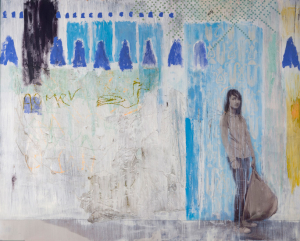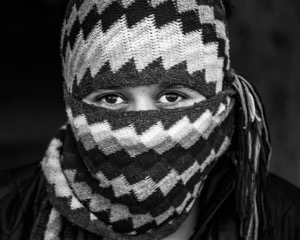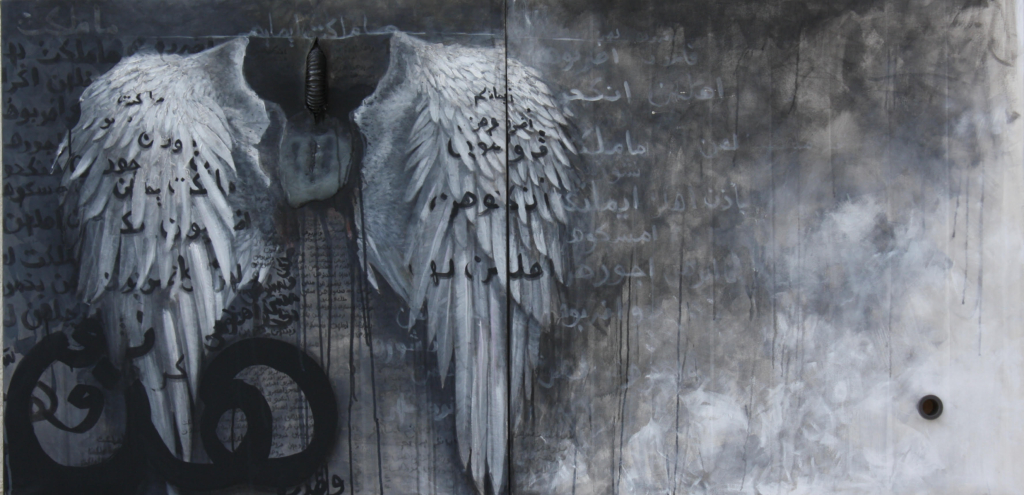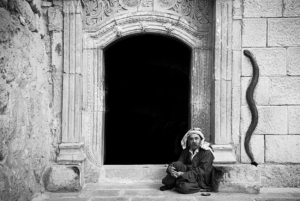Our Silent Auction will feature a range of art from local and international artists who present their views and perspectives of Kurdistan.
Charlie Calder-Potts www.charlie-calderpotts.com 
Charlie Calder-Potts is a British artist working with mixed media from her studio in London, who has had many notable exhibitions and commissions in the UK and abroad.
Her most recent solo exhibition “Book of Kings” featured work from Iraqi Kurdistan (2015) and from her time as an Official War Artist with the British Army in Afghanistan in (2013/2014). ‘I am here’ is a piece based on her time in Sulaymaniyah, Kurdistan. She etched the photographic image of a Kurdish girl in Western dress onto a sheet of metal, to give a snapshot of everyday life. The piece also gives an insight into the history of the city, as she built the picture up in layers, with oil paint, pastel, pencil, ink, and crumpled tissue, applied in veils of texture and patterned color. The ‘Aomer’ graffiti is copied from the walls of the Saddam era prison in the city center and the triangular windows and geometric design above is a nod to the traditional architecture of the beautiful ancient buildings that make up so much of the city. The title itself – I am here – is from an inscription the artist found carved into the walls of one of the prison cells; repeated over and over again with different dates alongside each line, spanning many years.
Giles Clarke www.gilesnclarke.com
Giles Clarke is an award-winning photojournalist with Getty Images Reportage, based in New York City. His work has been featured by Amnesty International, Human Rights Watch, CNN, Yahoo News, The Guardian, Global Witness, The New Yorker, Paris Match, and VICE amongst others. In 2015 and 2016, he received multiple awards for his body of work, “Toxic Trespass” about the Bhopal gas tragedy in India, considered the world’s worst industrial disaster, exposing over 520,000 people to toxic waste. His series about Kurdistan, “UpRooted” speaks to both the suffering and brave and strong people who have endured unspeakable horrors in the tormented region of Iraq and Syria.
Ava Nadir
Ava Nadir is an Iraqi artist based in Kurdistan, known for her provocative and controversial pieces and subjects related to women in conflict and fear, and women’s rights between culture and religion. Having lived most of her life under war in Baghdad, her inspiration comes from her life experiences as a woman living under political, social, cultural and religious pressure.
Her current work is part of series inspired by the oppression of woman under religious extremism. In Silence of Wings, Ava explores women’s rights, roles, and relationships in the Middle East. The piece reflects the words that she feels have been used to control women’s behavior, to judge their dignity and honor, restrict their freedom and very existence — to literally “clip their wings.” She includes the words but splits them, burying them in the wings to break their power and diminish their holiness. Most notable is “ملكت إيمانكم” (Malakat Aymanakom) which has used to justify the most horrific abuse and enslavement. The pipe and small hole represent the woman’s struggle to breathe, as these restrictions affect all women in the modern Middle East, even at the highest level of society.
Adam Mirani www.miranimaging.com
Adam Mirani is a Kurdish Canadian photographer living in Erbil, Kurdistan. His work ranges from shooting the red carpets of the Toronto International Film Festival to the oil fields of Kurdistan. Through his images, we see the beauty of the landscapes and portraits of its amazing and diverse population, helping to tell the stories of Kurdistan.
The Hasar Mountain range, featured in the first image, was a base for the Peshmerga fighting against the Baath regime. A stunningly beautiful landscape with a tragically violent history, something which can be said about the vast majority of places in Kurdistan. The second image features Baba Jawish, the caretaker of the most important Yezidi temple, Lalish, in the Iraqi Kurdistan Region. The black snake is an ancient sacred symbol found at Yezidi holy sites. According to Yezidi mythology, it was a black snake that saved Noah and his precious cargo from drowning in the waters of the Flood, when his ark foundered on the peak of Mount Judi and started to leak. By coiling itself over the hole, the snake secured the survival of human and animal- kind. Four of Adam Mirani’s images will be featured at the auction.
Many thanks to all of our corporate sponsors for their generous contributions!














